There are 6,909 distinct languages in the world. So it’s no wonder that communication can be tricky on occasion. But, sometimes, even if we speak the same language, it still seems difficult to make ourselves understood.
We’ve all had experiences where it seems like you’re going over the same conversation again or again. Or no-one seems to be listening to each other.
Why is it so hard to find common ground? Or even to, very simply, agree on what was said?
In this complete guide to communication management, we’ll explore why your business’ growth may depend on effective communication — and why successful project outcome definitely does.
We’ll also look at why agreeing on a way forward can sometimes feel so challenging, what collaboration tools can make your life a whole lot easier, and what you can do to make 2023 your most communicative year ever.
What’s so important about communication anyway?
We’re all told that communication is important. And we’ve all likely been part of a situation where communication has been, umm, less than effective.
But, why is it so important?
When you think back to your experience of when communication went wrong, how did you feel? Frustrated, confused, or disengaged?
It’s hard to feel those things at any time, but it’s disastrous for delivering projects.
Why is project communication important for business stakeholders?
Projects are all about change. And we know that, for most of us, change is as comfortable as a shirt and tie in 100 degree heat. On the subway.
All the big change management theorists say building the right environment for change is crucial for success. Notably, talking about how great life will be after the project. This builds interest in the project and the appetite to move forward, lowering resistance to change.
Communicating the future-state keeps everyone’s eyes on the prize, so they don’t get disgruntled or want to call it quits when you hit the first snag (which you will.)
Why is communication important for the project sponsor?
Your project sponsor is like your own personal cheerleader. They’re heavily invested in seeing your project succeed and are always in your corner.
Best of all, this person is often an executive with the knowledge and power to help clear hurdles and boost your chances of success.
But, they’re not very effective if they’re left in the dark.
Good communication is essential for keeping your sponsor up-to-date and engaged.
Throughout the project lifecycle, effectively communicating project progress to the sponsor allows them to prepare the business for implementation, reassures them everything is on track, and let’s them know when you can use their involvement or advice.
Why is communication important for your project team?
Most people are motivated by getting things done and feeling like they are creating value.
It’s frustrating for project team members to complete a task only to realize two other people were also working on it. Or to disappoint the project manager by not completing something they didn’t realize was their responsibility.
Good communication leads to greater team efficiency and cohesion, and less time and effort wasted on duplicated tasks. Wasted time decreases the overall value of the project and is disheartening for everyone.
Let’s look at the benefits of good communications management and the risks of poor communications management.
Benefits
- Increased efficiency. With an effective communications plan, the right people get the right information when they need it. Which means time isn’t wasted by people trying to hunt it down.
- Increased clarity. When people don’t have the right information, they tend to work from assumptions. This can lead to mistakes, confusion, and frustration. More time gets wasted as mistakes are corrected and ruffled feathers are smoothed.
- Decreased risk. An effective communications plan means only those who need the information receive it. When information is sensitive, for example about a first-to-market product, this is critical. Early release of confidential information could result in reputational or financial risk to the company.
Risks
- Lack of engagement. This is a key risk in every project. Engaging stakeholders and taking them on the journey with you is crucial to successfully implementing a project.
- Increased cost. Incorrect or missing information can lead to mistakes. Sorting these mistakes out can be costly. Good communication management is critical if you don’t want to see your budget disappearing because Kevin attached the wrong thingamajigger to the wrong doo-dah.
- Project delays. While we’re talking about things that can affect your “iron triangle” of success, ineffective communication can result in significant delays. If you don’t identify the correct stakeholders in your communication planning phase and miss out, say, sign-off from a regulatory body, you could still be twiddling your thumbs months after your expected closure date.
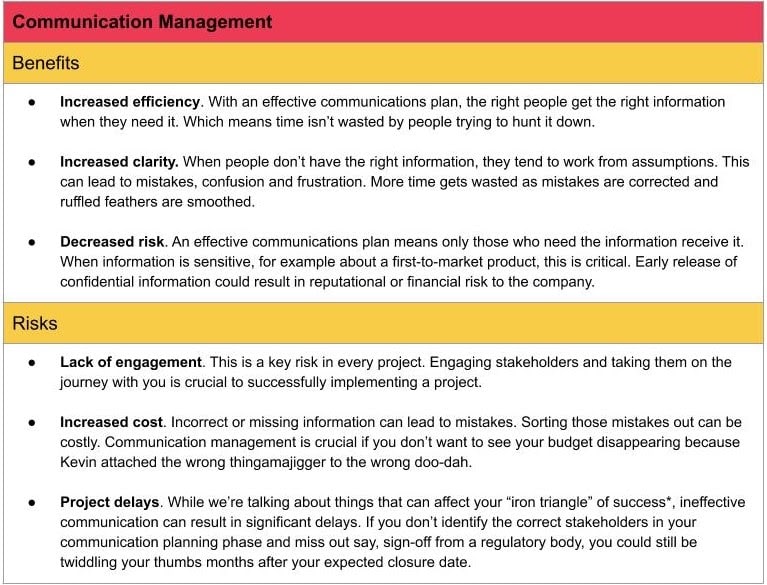
Poor communication can lead to unclear goals, misunderstandings about requirements, disengaged stakeholders, and lots of other issues that will cause your project to bomb.
What are the principles of effective communication management?
The principles of effective communication management can be split into 2 areas: Processes and Skills
What process should I follow?
The Project Management Book of Knowledge (aka ‘The Handbook’) describes 3 key stages for effective communication management:
- Plan communications management
- Manage communications
- Monitor communications
Let’s break them down:
Planning communications management
When you’re planning your project communications you first need to get clear on what impact you’re trying to create with your communications.
Are you updating people? Engaging them? Persuading them?
This will help you to identify who you need to speak to and what type of message they need to receive and understand. It will also influence what channels, methods, and tools you use for your communications.
To start, gather all the information you already have from the project charter, project management plan, stakeholder analysis, and company culture analysis about who should be kept in the loop and what kind of communications they should receive.
Then decide how and when you want to reach your stakeholders. Will this have a set frequency or just at key milestones? Will you have regular meetings or an ad-hoc newsletter? Remember to think of how you’ll communicate and collaborate effectively as a project team too.
You’ll likely have different types and frequency of communications for different groups of people.
While your team might discuss updates every day, chances are you don’t touch base with your executives or client that often — unless they’re overly keen.
The output from this stage is your communications plan (more on this below).
Managing communications
This is where all the planned communications are put into action. That might be regular progress update meetings, status reports, project highlights in the company newsletter, or even more formal ‘town halls’.
You’ll also need to make sure there is an effective feedback mechanism so stakeholders have a way to tell you, informally or formally, what they’re really thinking!
Organizing, actioning, and storing communications will also be important and should be a key responsibility of someone on the project team.
You’ll want to be able to easily locate any past communications you’ve sent out and any queries, concerns, or other responses people have provided. This helps prevent the dreaded “you never told me that!”
Monitoring communications
Like all other project controls, it’s important for project managers to check if their communications are having the desired impact.
Feedback can be sought from project stakeholders as to the value of communications so the message or channel can be adjusted as required.
No one enjoys sending out a report every week that no one bothers to read. Even if a platform like monday.com makes it super fast and easy to create reports, it’s still annoying.
Feedback can also be used to update your stakeholder analysis to make sure you’re retaining the support of those who are championing your project and decreasing the resistance of those who aren’t.
What if a key supporter of your project jumps ship for another company?
Without monitoring and updating your management plan to keep tabs on stakeholders, you’ll be blindly sending reports to a ghost while their new replacement hasn’t been won over yet.
What skills do I need for effective communication management?
Alongside an effective process, there are also some key skills required to make sure you’re getting your message across.
Great communication skills aren’t just about speaking. Being a good listener is equally, if not more, important for project success.Active listening requires looking for non-verbal cues as well as what’s being said. You’ll need to:
- Reflect back and summarize what you’ve heard. This allows you to check your understanding and also reassures the speaker that you’re listening and that you know what they’re saying is important to them.
- Be good at compromising and negotiating. It’s unlikely that everything you propose will be immediately accepted, no matter how good a communicator you are! So you’ll need to be comfortable working to find a position that all parties are happy with.
This isn’t just for external stakeholders either. Trying to see other people’s point of view is also important for effective collaboration (and maintaining harmony) within the project team.
- Understand stakeholder motivation. You’ll need super-sleuthing skills to try to make sense of what is driving various stakeholders’ positions and therefore what communication method is best to engage and persuade them.
- Communicate effectively. Obviously, you’ll also need to be able to communicate well, both verbally and in written form. If this is not your strong point, make it a priority to find someone who does this really well and delegate.
How should I structure a good communications plan?
Firstly, let’s discuss the difference between your communication plan and your wider communication strategy.
The first gives you a more strategic perspective, you’ll need to identify what your objective is and what success looks like. The second gives you the detail — who, when, and how.
Let’s start with your strategy as it’ll drive your plan:
8 aspects of a solid communication strategy
The Association for Project Management (APM) details 8 key components for a good communication strategy. Let’s look at each in detail:
- Housekeeping. This explains how you’re going to administer the strategy itself. It will include version control and information on who needs to sign-off on various communications.
- Scope. A classic in project management! This simply explains what the strategy covers and what it doesn’t. This might include timescales — does the strategy cover the whole project lifecycle or just the execution phase?
- Background research. This includes your stakeholder and organizational culture analysis. It might also include research on what communication channels are available in the organization, and any information on which of those tend to be the most effective.
- Objectives. In this section, you’ll need to create some SMART objectives about the intended outcome of your communications. What do you want people to do or think differently about after they receive your message? You may well need different objectives for different stakeholder groups.
- Stakeholders. Speaking of stakeholders, what do you know about them? You can expand on your stakeholder analysis to prioritize which groups you are going to target with your communications. You can also consider where key stakeholders might lie on a classic ‘interest vs. influence’ matrix and where you might need to move them to ensure project success.
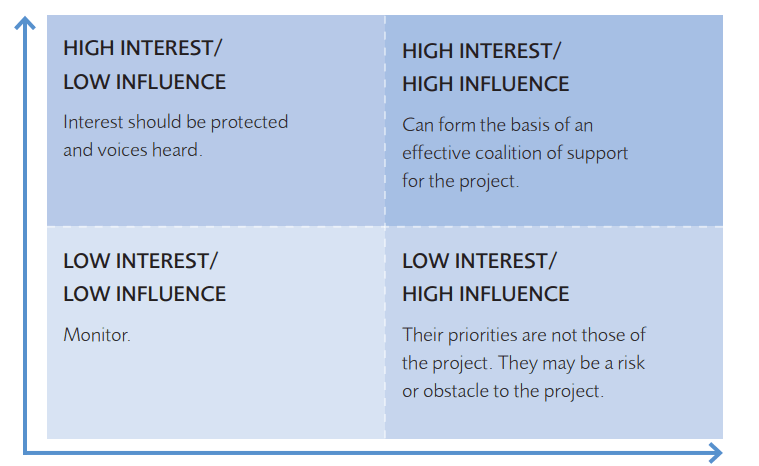
- Message and narrative. This is where you identify the style of your verbal and written communications. Is the company culture more or less formal? Do you want a list of simple bullet points or are you going to use visioning and storytelling to paint a positive picture of life after the project?
- Channels. Communication channels are the ways in which we reach our audience — online or paper newsletters, email, face-to-face presentations, social media, etc. You’ll also decide what type of media is suited to which channels and whether you’ll use push or pull communications.
Sidebar: some key terms explained
Push and pull communications
Push communications are those ‘pushed’ from the communications manager to the audience. An email newsletter would be an example of a push communication.
Pull communications are those that rely on the audience seeking or ‘pulling’ the information out. An example would be a project intranet page.
Rich and lean media
Rich media channels are used when you need to explore and agree on difficult or sensitive issues. They’re characterized by the ability for rapid feedback, personal interaction, and both verbal, and non-verbal, cues. An example would be a face-to-face workshop.
Lean media channels are used for communicating routine information where it’s less important that the message is received and acted on. An example would be a poster on a work bulletin board.
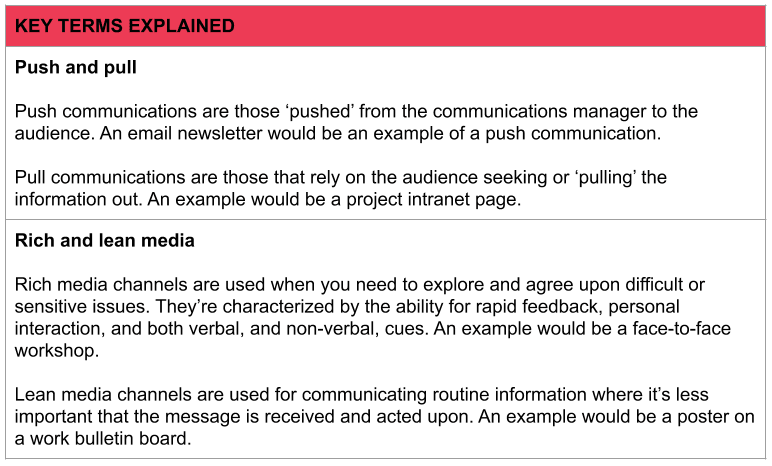
- Evaluation. It’s important to monitor how well your communication strategy is working. Quantitative surveys are an easy way to check if information was received. To confirm your message was understood and has had an impact, you’ll probably need qualitative evaluation such as focus groups.
Once you’ve prepared your communications strategy, you can get into the nuts and bolts of your project communication plan.
5 elements of a strong communication plan
Your planning document should cover 5 key elements:
- When? The date or time period when the messages will be released. Will you have daily meetings? If so, what time? If you’re planning weekly reports, what day will they be sent? What about bi-weekly and monthly communications?
- Who? The intended audience of the message. You’ll need a separate row in your plan for each individual or group of stakeholders you intend to communicate with.
- What? What type of channel and media you are going to use. Will you have face-to-face meetings or Zoom calls? Will you email reports or publish them in your Work OS and send out notifications when they’re available?
- Why? What’s the purpose of this communication? Which objective will it help you meet? What has the stakeholder asked to be kept in the loop about?
- How? How will you evaluate whether the communication was successful? Are you tracking meeting attendance or read notifications? Will you be sending out follow-up surveys?
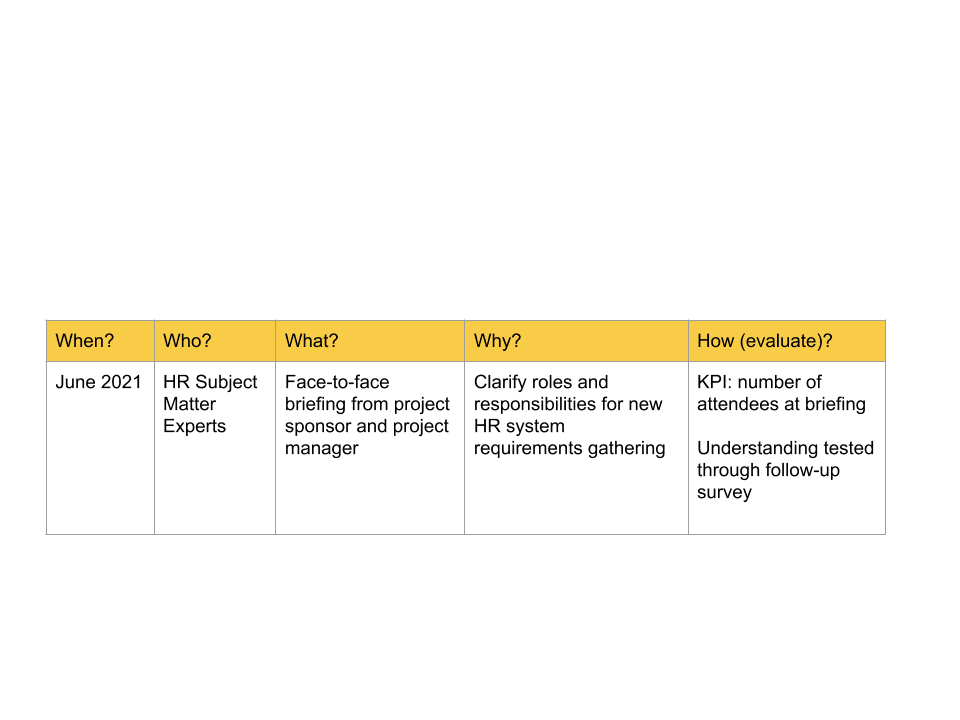
What else can help?
There are a number of different documents, tools, and collaboration apps that can make your communication management much easier. Happily, monday.com has them all!
You’ll need to consider the documents you need to support your communication strategy and communication plan. As we’ve discussed, you’ll need various pieces of information to help build your plan, such as the project charter and stakeholder register.
monday.com makes this simple, with over 200 engaging and intuitive templates ready for you to use including both of these and, of course, a communications plan.
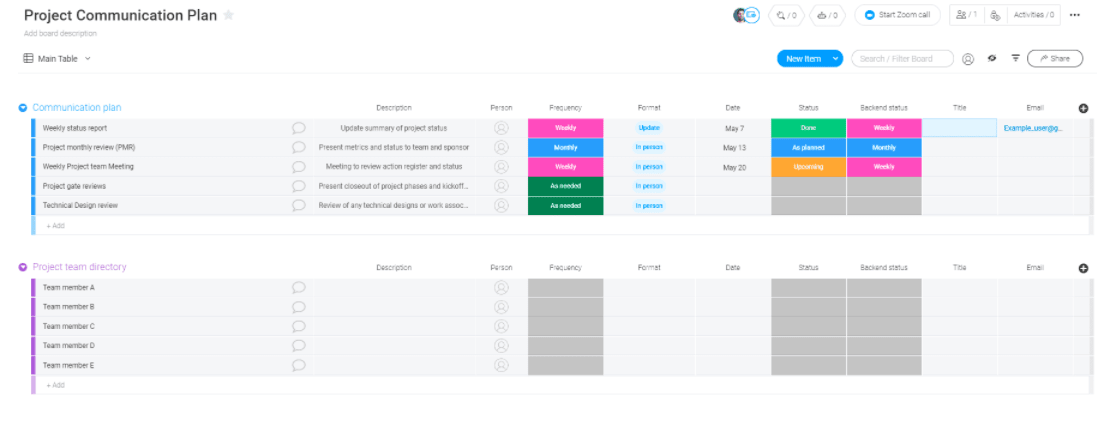
Communication and collaboration within the project team are as important as communicating with business or external stakeholders. monday.com makes it easy, with the ability to share files, comment on documents, and drag-and-drop task reprioritization.
You can also use the calendar view to plan communication events. You can add a task for the dates you plan to share information and add descriptions, file attachments, comments, and notes.
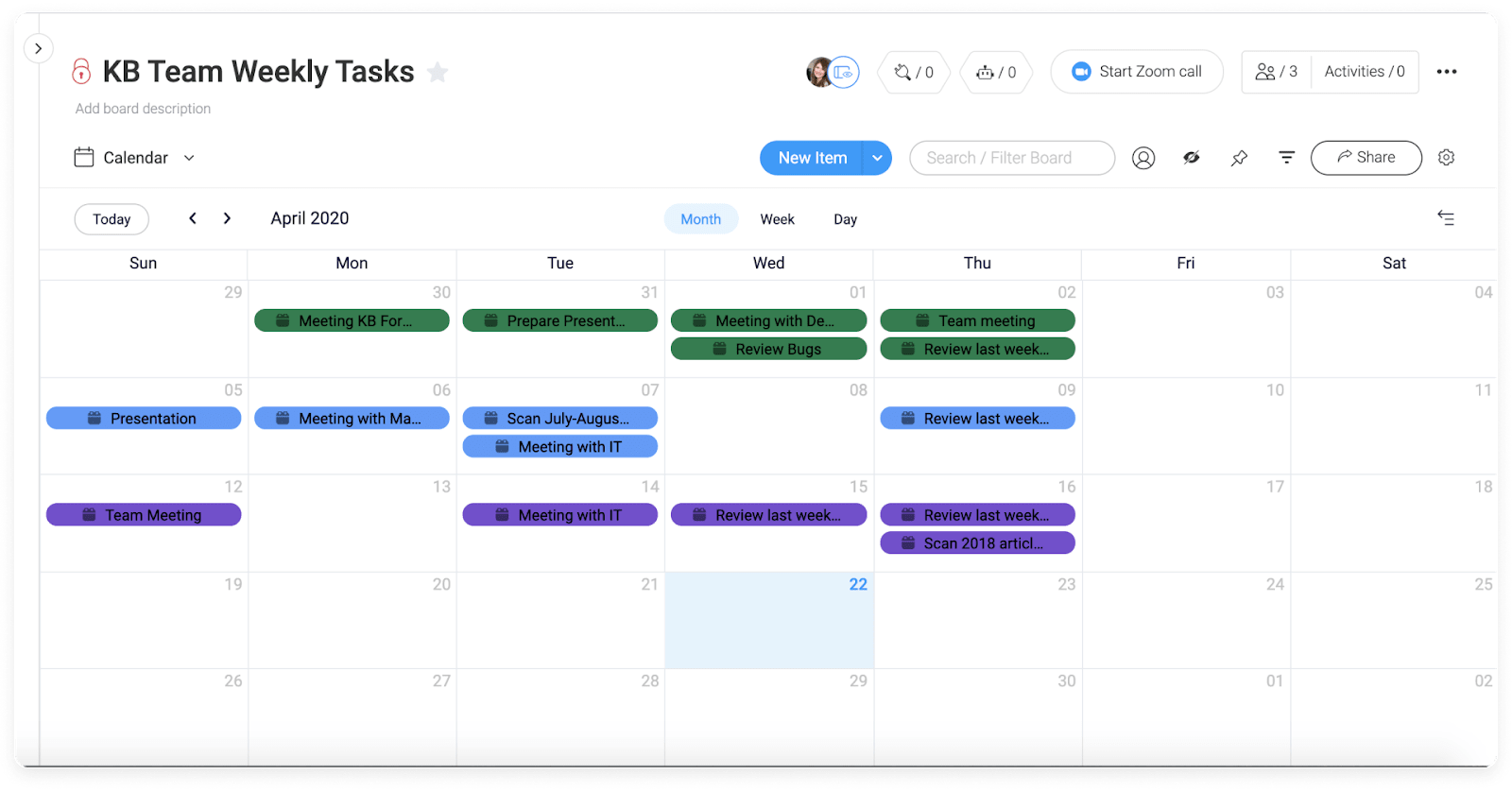
The monday.com Work OS also integrates with all your favorite collaboration tools making effective communication easy as pie.
Using a platform like monday.com offers the whole project team transparency. If everyone can see what is planned, they can pitch ideas, or offer their perspective from what they’ve experienced with stakeholders on the ground, to improve the approach.
This is what happened for global professional services firm, Genpact. After switching to monday.com, they saw a 40% rise in cross-team collaboration for successful campaign planning. Read more about their success story here.
Conclusion
Phew! We covered a lot. But we did promise you comprehensive, right? Now you’ve got all the tools you need to make 2021 your most collaborative and productive yet.
And, if nothing else, you’ll be able to practice a little extra ‘peace and understanding’ as you try to navigate family lockdown during Christmas.
If you can make it through that minefield, projects will be a piece of cake!
Try out our project communication plan template and discover how monday.com can make your communication management a breeze.


